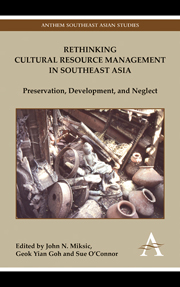Book contents
Chapter 1 - Thinking about Popular Religion and Heritage
from Southeast Asia (General)
Published online by Cambridge University Press: 05 May 2012
Summary
Introduction
In Southeast Asia, archaeology has only been practiced since the nineteenth century and the discourse of heritage is similarly recent. This does not, of course, mean that prior to the appearance of archaeology and heritage the physical traces of the past were meaningless to people in Southeast Asia. In Thailand, for instance, the practice of venerating the remains of old and ancient Buddhist monuments has a very long lineage (e.g. Wyatt 2001) and we know that Buddhism, on colonizing the landscape of presentday Thailand from the sixth century AD, assimilated itself to much older traditions of venerating spirits of place via what Paul Mus (1975) termed “cadastral cults.” We know that traditions such as these have continued to inform the way many or most people in Southeast Asia relate to old places and things (e.g. Byrne 2009).
Curiously, archaeologists and heritage practitioners working in Southeast Asia tend to be silent about these popular practices despite the fact that they have received considerable attention by anthropologists and historians. My particular focus in this chapter is the way that popular religion in Southeast Asia provides a context for the relationships many people have with the material past in the landscapes of everyday life. The belief people have that old places and things are occupied and animated by spirits and deities, that they have magical-supernatural properties, or that they are sacred within the context of mainstream religions such as Buddhism, is of central interest to me.
- Type
- Chapter
- Information
- Rethinking Cultural Resource Management in Southeast AsiaPreservation, Development, and Neglect, pp. 3 - 14Publisher: Anthem PressPrint publication year: 2011
- 5
- Cited by



